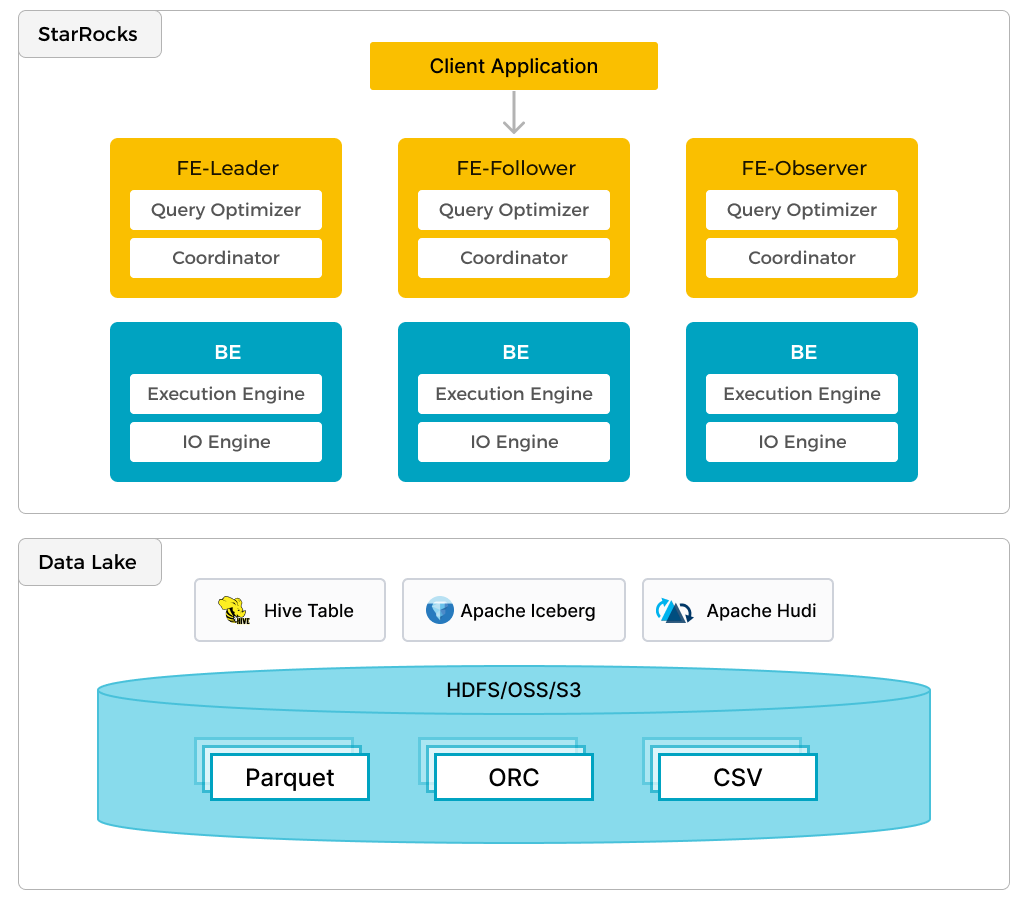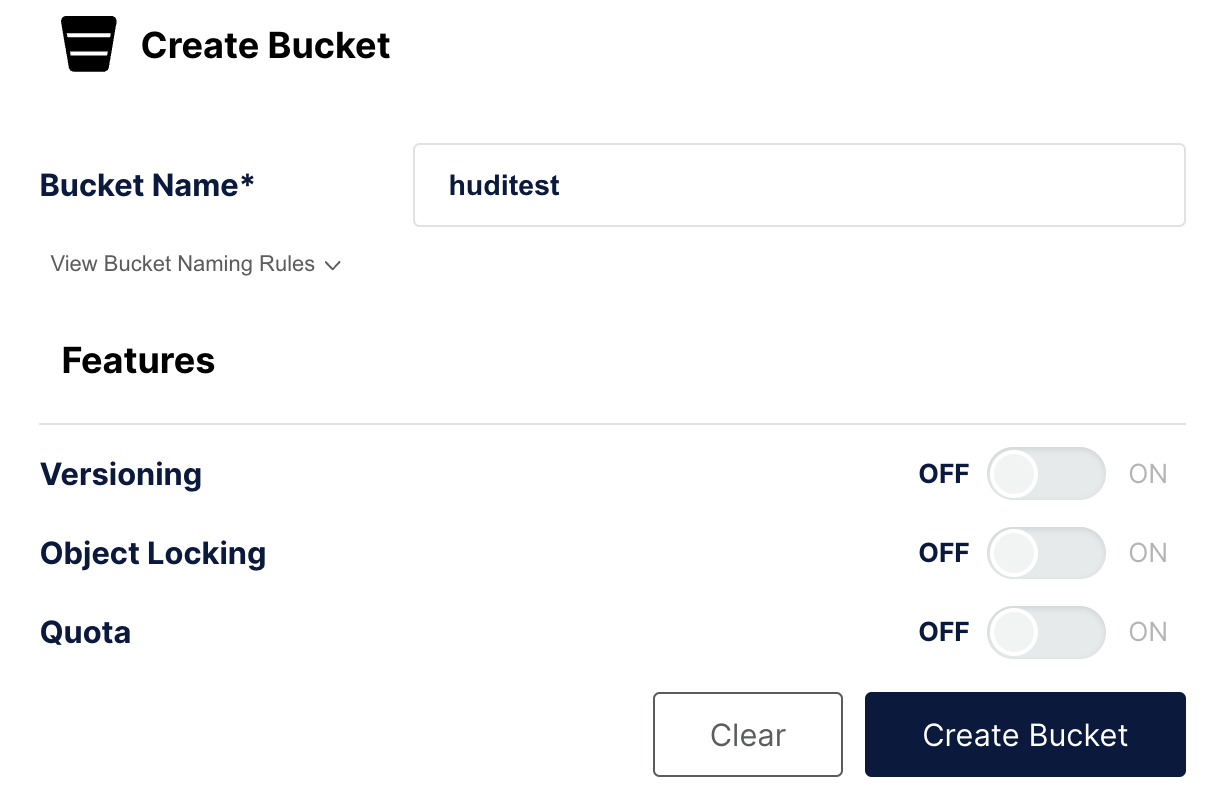Apache Hudi Lakehouse
Overview
- Deploy Object Storage, Apache Spark, Hudi, and StarRocks using Docker compose
- Load a tiny dataset into Hudi with Apache Spark
- Configure StarRocks to access the Hive Metastore using an external catalog
- Query the data with StarRocks where the data sits

In addition to efficient analytics of local data, StarRocks can work as the compute engine to analyze data stored in data lakes such as Apache Hudi, Apache Iceberg, and Delta Lake. One of the key features of StarRocks is its external catalog, which acts as the linkage to an externally maintained metastore. This functionality provides users with the capability to query external data sources seamlessly, eliminating the need for data migration. As such, users can analyze data from different systems such as HDFS and Amazon S3, in various file formats such as Parquet, ORC, and CSV, etc.
The preceding figure shows a data lake analytics scenario where StarRocks is responsible for data computing and analysis, and the data lake is responsible for data storage, organization, and maintenance. Data lakes allow users to store data in open storage formats and use flexible schemas to produce reports on "single source of truth" for various BI, AI, ad-hoc, and reporting use cases. StarRocks fully leverages the advantages of its vectorization engine and CBO, significantly improving the performance of data lake analytics.
Prerequisites
StarRocks demo repository
Clone the StarRocks demo repository to your local machine.
All the steps in this guide will be run from the demo/documentation-samples/hudi/ directory in the directory where you cloned the demo GitHub repo.
Docker
- Docker Setup: For Mac, Please follow the steps as defined in Install Docker Desktop on Mac. For running Spark-SQL queries, please ensure at least 5 GB memory and 4 CPUs are allocated to Docker (See Docker → Preferences → Advanced). Otherwise, spark-SQL queries could be killed because of memory issues.
- 20 GB free disk space assigned to Docker
SQL client
You can use the SQL client provided in the Docker environment, or use one on your system. Many MySQL compatible clients will work.
Configuration
Change directory into demo/documentation-samples/hudi and look at the files. This is not a tutorial on Hudi, so not every configuration file will be described; but it is important for the reader to know where to look to see how things are configured. In the hudi/ directory you will find the docker-compose.yml file which is used to launch and configure the services in Docker. Here is a list of those services and a brief description:
Docker services
| Service | Responsibilities |
|---|---|
starrocks-fe | Metadata management, client connections, query plans and scheduling |
starrocks-be | Running query plans |
metastore_db | Postgres DB used to store the Hive metadata |
hive_metastore | Provides the Apache Hive metastore |
minio and mc | MinIO Object Storage and MinIO command line client |
spark-hudi | Distributed computing and Transactional data lake platform |
Configuration files
In the hudi/conf/ directory you will find configuration files that get mounted in the spark-hudi
container.
core-site.xml
This file contains the object storage related settings. Links for this and other items in More information at the end of this document.
spark-defaults.conf
Settings for Hive, MinIO, and Spark SQL.
hudi-defaults.conf
Default file used to silence warnings in the spark-shell.
hadoop-metrics2-hbase.properties
Empty file used to silence warnings in the spark-shell.
hadoop-metrics2-s3a-file-system.properties
Empty file used to silence warnings in the spark-shell.
Bringing up Demo Cluster
This demo system consists of StarRocks, Hudi, MinIO, and Spark services. Run Docker compose to bring up the cluster:
docker compose up --detach --wait --wait-timeout 60
[+] Running 8/8
✔ Network hudi Created 0.0s
✔ Container hudi-starrocks-fe-1 Healthy 0.1s
✔ Container hudi-minio-1 Healthy 0.1s
✔ Container hudi-metastore_db-1 Healthy 0.1s
✔ Container hudi-starrocks-be-1 Healthy 0.0s
✔ Container hudi-mc-1 Healthy 0.0s
✔ Container hudi-hive-metastore-1 Healthy 0.0s
✔ Container hudi-spark-hudi-1 Healthy 0.1s
With many containers running, docker compose ps output is easier to read if you pipe it to jq:
docker compose ps --format json | \
jq '{Service: .Service, State: .State, Status: .Status}'
{
"Service": "hive-metastore",
"State": "running",
"Status": "Up About a minute (healthy)"
}
{
"Service": "mc",
"State": "running",
"Status": "Up About a minute"
}
{
"Service": "metastore_db",
"State": "running",
"Status": "Up About a minute"
}
{
"Service": "minio",
"State": "running",
"Status": "Up About a minute"
}
{
"Service": "spark-hudi",
"State": "running",
"Status": "Up 33 seconds (healthy)"
}
{
"Service": "starrocks-be",
"State": "running",
"Status": "Up About a minute (healthy)"
}
{
"Service": "starrocks-fe",
"State": "running",
"Status": "Up About a minute (healthy)"
}
Configure MinIO
When you run the Spark commands you will set the basepath for the table being created to an s3a URI:
val basePath = "s3a://huditest/hudi_coders"
In this step you will create the bucket huditest in MinIO. The MinIO console is running on port 9000.
Authenticate to MinIO
Open a browser to http://localhost:9000/ and authenticate. The username and password are specified in docker-compose.yml; they are admin and password.
Create a bucket
In the left navigation select Buckets, and then Create Bucket +. Name the bucket huditest and select Create Bucket

Create and populate a table, then sync it to Hive
Run this command, and any other docker compose commands, from the directory containing the docker-compose.yml file.
Open spark-shell in the spark-hudi service
docker compose exec spark-hudi spark-shell
There will be warnings when spark-shell starts about illegal reflective access. You can ignore these warnings.
Run these commands at the scala> prompt to:
- Configure this Spark session to load, process, and write data
- Create a dataframe and write that to a Hudi table
- Sync to the Hive Metastore
import org.apache.spark.sql.functions._
import org.apache.spark.sql.types._
import org.apache.spark.sql.Row
import org.apache.spark.sql.SaveMode._
import org.apache.hudi.DataSourceReadOptions._
import org.apache.hudi.DataSourceWriteOptions._
import org.apache.hudi.config.HoodieWriteConfig._
import scala.collection.JavaConversions._
val schema = StructType( Array(
StructField("language", StringType, true),
StructField("users", StringType, true),
StructField("id", StringType, true)
))
val rowData= Seq(Row("Java", "20000", "a"),
Row("Python", "100000", "b"),
Row("Scala", "3000", "c"))
val df = spark.createDataFrame(rowData,schema)
val databaseName = "hudi_sample"
val tableName = "hudi_coders_hive"
val basePath = "s3a://huditest/hudi_coders"
df.write.format("hudi").
option(org.apache.hudi.config.HoodieWriteConfig.TABLE_NAME, tableName).
option(RECORDKEY_FIELD_OPT_KEY, "id").
option(PARTITIONPATH_FIELD_OPT_KEY, "language").
option(PRECOMBINE_FIELD_OPT_KEY, "users").
option("hoodie.datasource.write.hive_style_partitioning", "true").
option("hoodie.datasource.hive_sync.enable", "true").
option("hoodie.datasource.hive_sync.mode", "hms").
option("hoodie.datasource.hive_sync.database", databaseName).
option("hoodie.datasource.hive_sync.table", tableName).
option("hoodie.datasource.hive_sync.partition_fields", "language").
option("hoodie.datasource.hive_sync.partition_extractor_class", "org.apache.hudi.hive.MultiPartKeysValueExtractor").
option("hoodie.datasource.hive_sync.metastore.uris", "thrift://hive-metastore:9083").
mode(Overwrite).
save(basePath)
System.exit(0)
You will see a warning:
WARN
org.apache.hudi.metadata.HoodieBackedTableMetadata -
Metadata table was not found at path
s3a://huditest/hudi_coders/.hoodie/metadata
This can be ignored, the file will be created automatically during this spark-shell session.
There will also be a warning:
78184 [main] WARN org.apache.hadoop.fs.s3a.S3ABlockOutputStream -
Application invoked the Syncable API against stream writing to
hudi_coders/.hoodie/metadata/files/.files-0000_00000000000000.log.1_0-0-0.
This is unsupported
This warning informs you that syncing a log file that is open for writes is not supported when using object storage. The file will only be synced when it is closed. See Stack Overflow.
The final command in the above spark-shell session should exit the container, if it doesn't press enter and it will exit.
Configure StarRocks
Connect to StarRocks
Connect to StarRocks with the provided MySQL client provided by the starrocks-fe service, or use your favorite SQL client and configure it to connect using the MySQL protocol on localhost:9030.
docker compose exec starrocks-fe \
mysql -P 9030 -h 127.0.0.1 -u root --prompt="StarRocks > "
Create the linkage between StarRocks and Hudi
There is a link at the end of this guide with more information on external catalogs. The external catalog created in this step acts as the linkage to the Hive Metastore (HMS) running in Docker.
CREATE EXTERNAL CATALOG hudi_catalog_hms
PROPERTIES
(
"type" = "hudi",
"hive.metastore.type" = "hive",
"hive.metastore.uris" = "thrift://hive-metastore:9083",
"aws.s3.use_instance_profile" = "false",
"aws.s3.access_key" = "admin",
"aws.s3.secret_key" = "password",
"aws.s3.enable_ssl" = "false",
"aws.s3.enable_path_style_access" = "true",
"aws.s3.endpoint" = "http://minio:9000"
);
Query OK, 0 rows affected (0.59 sec)
Use the new catalog
SET CATALOG hudi_catalog_hms;
Query OK, 0 rows affected (0.01 sec)
Navigate to the data inserted with Spark
SHOW DATABASES;
+--------------------+
| Database |
+--------------------+
| default |
| hudi_sample |
| information_schema |
+--------------------+
2 rows in set (0.40 sec)
USE hudi_sample;
Reading table information for completion of table and column names
You can turn off this feature to get a quicker startup with -A
Database changed
SHOW TABLES;
+-----------------------+
| Tables_in_hudi_sample |
+-----------------------+
| hudi_coders_hive |
+-----------------------+
1 row in set (0.07 sec)
Query the data in Hudi with StarRocks
Run this query twice, the first time may take around five seconds to complete as data is not yet cached in StarRocks. The second query will be very quick.
SELECT * from hudi_coders_hive\G
Some of the SQL queries in the StarRocks documentation end with \G instead
of a semicolon. The \G causes the mysql CLI to render the query results vertically.
Many SQL clients do not interpret vertical formatting output, so you should replace \G with ; if you are not using the mysql CLI.
*************************** 1. row ***************************
_hoodie_commit_time: 20240208165522561
_hoodie_commit_seqno: 20240208165522561_0_0
_hoodie_record_key: c
_hoodie_partition_path: language=Scala
_hoodie_file_name: bb29249a-b69d-4c32-843b-b7142d8dc51c-0_0-27-1221_20240208165522561.parquet
language: Scala
users: 3000
id: c
*************************** 2. row ***************************
_hoodie_commit_time: 20240208165522561
_hoodie_commit_seqno: 20240208165522561_2_0
_hoodie_record_key: a
_hoodie_partition_path: language=Java
_hoodie_file_name: 12fc14aa-7dc4-454c-b710-1ad0556c9386-0_2-27-1223_20240208165522561.parquet
language: Java
users: 20000
id: a
*************************** 3. row ***************************
_hoodie_commit_time: 20240208165522561
_hoodie_commit_seqno: 20240208165522561_1_0
_hoodie_record_key: b
_hoodie_partition_path: language=Python
_hoodie_file_name: 51977039-d71e-4dd6-90d4-0c93656dafcf-0_1-27-1222_20240208165522561.parquet
language: Python
users: 100000
id: b
3 rows in set (0.15 sec)
Summary
This tutorial exposed you to the use of a StarRocks external catalog to show you that you can query your data where it sits using the Hudi external catalog. Many other integrations are available using Iceberg, Delta Lake, and JDBC catalogs.
In this tutorial you:
- Deployed StarRocks and a Hudi/Spark/MinIO environment in Docker
- Loaded a tiny dataset into Hudi with Apache Spark
- Configured a StarRocks external catalog to provide access to the Hudi catalog
- Queried the data with SQL in StarRocks without copying the data from the data lake
More information
Apache Hudi quickstart (includes Spark)
